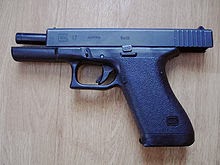A light
machine gun (LMG) is a machine gun designed to be employed by an individual
soldier, with or without an assistant, as an infantry support weapon. Light
machine guns are often used as squad automatic weapons.
 |
| Light machine gun in mountains |
Characteristics
Modern light
machine guns often fire smaller-caliber cartridges than medium machine guns, and
are usually lighter and more compact. Some LMGs, such as the Russian RPK, are
modifications of existing assault rifle designs and designed to share the same
ammunition. Adaptations to the original rifle generally include a larger
magazine, a heavier barrel to resist overheating, a more robust mechanism to
support sustained fire and a bipod.
A light
machine gun is also defined by its usage as well as its specifications: some
machine guns - notably general-purpose machine guns - may be deployed either as
a light machine gun or a medium machine gun. Deployed on a tripod and used for
sustained-fire it is a medium machine gun; if deployed with a bipod with the
operator in prone position and firing short bursts it is a light machine gun.
Light
machine guns are also designed to be fired from the hip or on the move as a
form of suppressive fire intended to pin down the enemy. Marching fire is a
specific tactic that relies on this capability.
Lighter
modern LMGs have enabled them to be issued down at the fireteam level, with two
or three at the section/squad level.
Ammunition
feed
Many light
machine guns (such as the Bren gun or the M1918 Browning Automatic Rifle) were
magazine-fed. Others, such as the MG 34, could be fed either from a belt or a
magazine. Modern light machine guns are designed to fire more rounds of a
smaller caliber and, as such, tend to be belt-fed from a detachable box
magazine, some such as the FN Minimi will also accept rifle magazine feeding as
an auxiliary measure when belted ammunition has been exhausted.
It is mainly used in wars or in areas which are situated with international borders....














